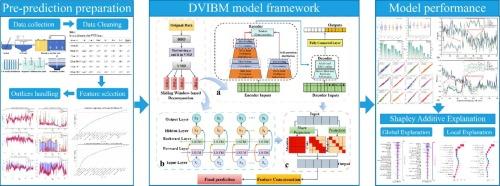An attention-based parallel model with sliding window decomposition algorithm for water quality prediction
IF 6.7
2区 工程技术
Q1 ENGINEERING, CHEMICAL
引用次数: 0
Abstract
Accurate forecasting of effluent water quality is essential for enhancing the safety and economic efficiency of wastewater treatment plants (WWTPs) due to the volatility and time-varying nature of effluent water quality. Representative neural networks, such as Long Short-Term Memory (LSTM), have been extensively employed in time-series prediction. However, as the volume of water quality data increases, these models become unstable, making accurate prediction challenging. This study proposes a hybrid prediction method, DVIBM, based on optimized decomposition for forecasting effluent water quality. DVIBM integrates the Dung Beetle Optimization (DBO) algorithm, Variational Mode Decomposition (VMD), Informer, Bidirectional Long Short-Term Memory (BiLSTM) network, and the multi-scale attention mechanism (MUSE). The DBO algorithm is employed to optimize the hyperparameters and in VMD, within a sliding window framework, to determine the decomposition bandwidth and the number of modes. The original water quality time-series is decomposed into multiple sub-series, with future data excluded during the process to effectively extract features while preventing data leakage. DVIBM couples Informer and BiLSTM via the MUSE attention mechanism, adaptively fusing multi-scale long- and short-term features, thereby reducing error accumulation and propagation in cascaded or single-architecture. Across varying sliding-window parameter combinations and time steps, as well as in ablation comparisons, DVIBM achieves MAE/MSE/R2 of 0.104/0.017/0.975 for effluent TN and 0.071/0.008/0.969 for TP, significantly outperforming the benchmark models. Global and local interpretability analyses of effluent TN and TP are conducted using the SHAP (Shapley Additive Explanations) algorithm, providing theoretical support for the interpretability of wastewater treatment systems.

一种基于注意力的并行模型滑动窗分解水质预测算法
由于污水处理厂出水水质具有波动性和时变特性,准确预测出水水质对提高污水处理厂的安全性和经济性至关重要。具有代表性的神经网络,如长短期记忆(LSTM)在时间序列预测中得到了广泛的应用。然而,随着水质数据量的增加,这些模型变得不稳定,使准确的预测变得困难。提出了一种基于优化分解的混合预测方法DVIBM,用于污水水质预测。DVIBM集成了屎壳虫优化(DBO)算法、变分模态分解(VMD)、Informer、双向长短期记忆(BiLSTM)网络和多尺度注意机制(MUSE)。采用DBO算法在滑动窗口框架内对VMD中的超参数α和k进行优化,确定分解带宽和模态数。将原始水质时间序列分解为多个子序列,在此过程中剔除未来数据,有效提取特征,同时防止数据泄漏。DVIBM通过MUSE注意机制将Informer和BiLSTM耦合在一起,自适应融合多尺度长短期特征,从而减少了级联或单架构下的误差积累和传播。在不同滑动窗口参数组合和时间步长以及消融比较中,DVIBM的出水TN MAE/MSE/R2为0.104/0.017/0.975,TP为0.071/0.008/0.969,显著优于基准模型。采用Shapley加性解释(Shapley Additive Explanations)算法对出水TN和TP进行全局和局部可解释性分析,为污水处理系统的可解释性提供理论支持。
本文章由计算机程序翻译,如有差异,请以英文原文为准。
求助全文
约1分钟内获得全文
求助全文
来源期刊

Journal of water process engineering
Biochemistry, Genetics and Molecular Biology-Biotechnology
CiteScore
10.70
自引率
8.60%
发文量
846
审稿时长
24 days
期刊介绍:
The Journal of Water Process Engineering aims to publish refereed, high-quality research papers with significant novelty and impact in all areas of the engineering of water and wastewater processing . Papers on advanced and novel treatment processes and technologies are particularly welcome. The Journal considers papers in areas such as nanotechnology and biotechnology applications in water, novel oxidation and separation processes, membrane processes (except those for desalination) , catalytic processes for the removal of water contaminants, sustainable processes, water reuse and recycling, water use and wastewater minimization, integrated/hybrid technology, process modeling of water treatment and novel treatment processes. Submissions on the subject of adsorbents, including standard measurements of adsorption kinetics and equilibrium will only be considered if there is a genuine case for novelty and contribution, for example highly novel, sustainable adsorbents and their use: papers on activated carbon-type materials derived from natural matter, or surfactant-modified clays and related minerals, would not fulfil this criterion. The Journal particularly welcomes contributions involving environmentally, economically and socially sustainable technology for water treatment, including those which are energy-efficient, with minimal or no chemical consumption, and capable of water recycling and reuse that minimizes the direct disposal of wastewater to the aquatic environment. Papers that describe novel ideas for solving issues related to water quality and availability are also welcome, as are those that show the transfer of techniques from other disciplines. The Journal will consider papers dealing with processes for various water matrices including drinking water (except desalination), domestic, urban and industrial wastewaters, in addition to their residues. It is expected that the journal will be of particular relevance to chemical and process engineers working in the field. The Journal welcomes Full Text papers, Short Communications, State-of-the-Art Reviews and Letters to Editors and Case Studies
 求助内容:
求助内容: 应助结果提醒方式:
应助结果提醒方式:


